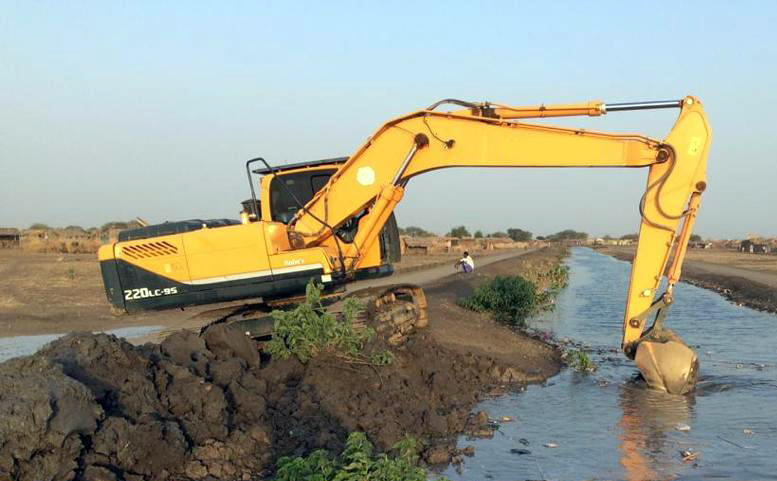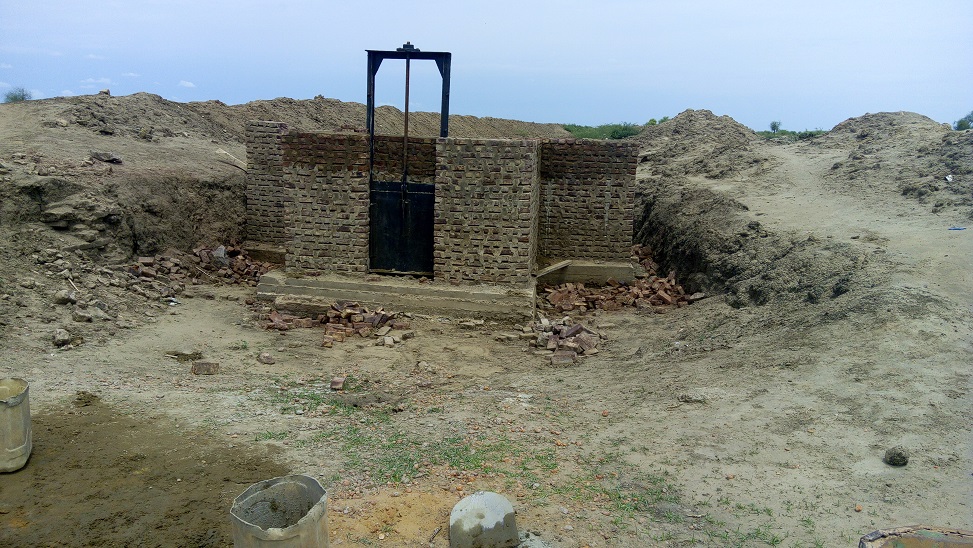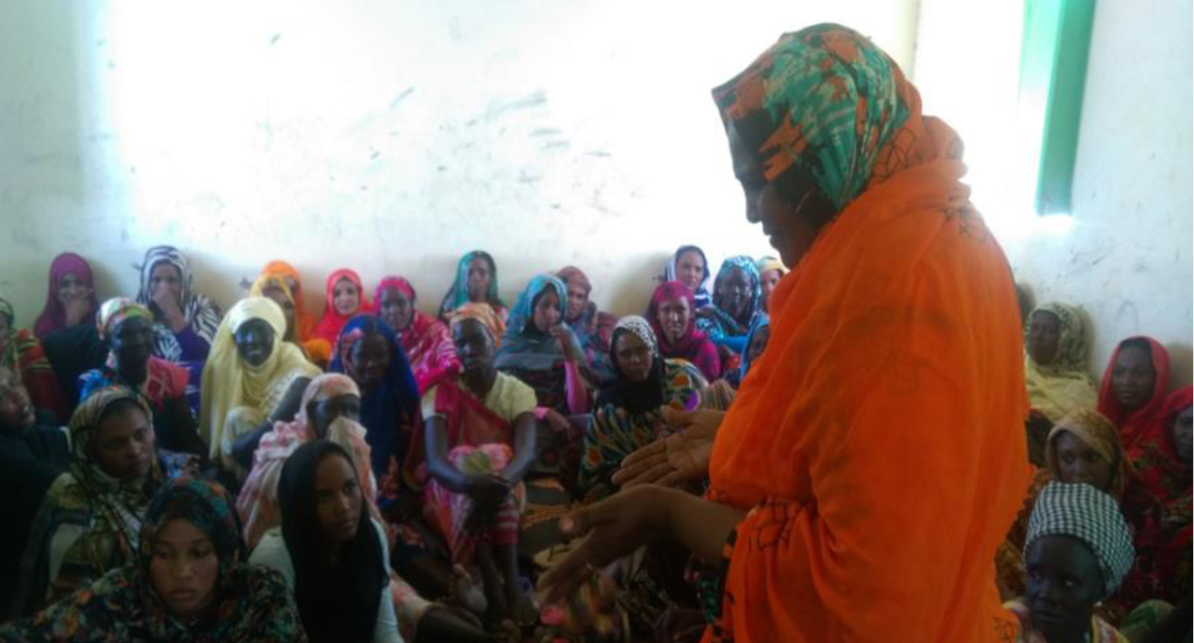Earthworks of the water canal in White Nile State. Photo: UNDP Sudan © 2019
White Nile State in Central Sudan has been facing a huge problem on account of influx of refugees coming from South Sudan as of 2017. Furthermore, the state, which is predominantly dependent on rainfed agriculture, also received an influx of nomads from north and northwest areas, as those areas have dried up and are suffering from desertification. As a result, most of the Sudanese states bordering South Sudan have witnessed an increase in conflicts between host communities and refugees and as well as between farmers and cattle herders.
After assessing perceptions of the communities, refugees and herders, it became evident for UNDP that a Programme based on the nexus between humanitarian, development and peace domains is imperative in order to meet the targets of SDG16, HDP nexus and address issues regarding the climate related security issues.
Given the experience of UNDP in those areas, it was obvious that piecemeal interventions of hosting a water well here and bore pump there will not work to resolve the issues related to conflicts due to the scale of the problem and the fact that the cattle herders have no choice but to move away from the areas of desertification and dwindling water resources. Additionally, the previous migration routes used by the herders were also affected by the ongoing instability in South Sudan and the border regions conflict between the rebel SPLM/N and Government of Sudan.
UNDP, following assessments of earlier projects by all UN agencies in the areas, and in consultations with all those affected, has embarked on the construction and rehabilitation of canals. Not only to expand cultivated areas, promote food security, enhance cash crops and livelihoods, but also to find sustainable solutions for managing conflicts caused by environmental changes and displacement.
In the process, refugees were given temporary employment b, not only in digging the canals but also in tilling, sowing, harvesting and packaging the produce like cotton. These profits were shared between the host communities and refugees. A number of unemployed people from the host communities were provided with livelihoods and refugees gained seasonal labor (which was also useful to the communities). This economic fabric was supported with the capacities to manage peace, which worked in a synergy. Three private sector companies saw the scale of the projects and sustainability, started ventured to buying, transport and market the produce and this created additional jobs along the value chains. This in turn pumped additional investment into the ventures, making them more sustainable. The cotton was sold to factories and export markets as proper value chains were established.
Areas witnessing nomadic movement could access water from the canals s, paying taxes to the local communities. The availability of water and economics promoted reconciliation between nomads and herders. This also resulted in building a corpus at the communities for using the funds collected out of taxes to rehabilitate basic services like schools and clinics, established by the humanitarian actors. This demonstrates a solid nexus between peace, humanitarian and development domains
At least 18,514 people from the host communities, nomads and refugee camps benefited directly from irrigation canals (The Canals and their lengths are: Jury 4km; Alkashafa 4.5km; Elridaiss 4km; ElIntisar 3km; Elshawa 3.5km; Elwarad 3km; Dabat Bosin 4.5km; Alagaya 5km; Juda 4km;).
The Community Management Committee (CMC), consisting of members of communities, nomads and the refugees, is responsible for collecting contributions from the farmers, in cash or in kind, during the harvest season. These contributions are deposited as savings in the CMC bank account and will be used for regular rehabilitation of the canals and running of the water pumps as agreed with communities, the water will flow to the farms through distribution canals (Abu eshrin and Abu seta). Memorandum of Understandings (MoU) have been signed in this regard between UNDP, the Ministry of Agriculture, the Ministry of Animal Resources and Peace Committee of the state.
Canals under construction in White Nile. Photo: UNDP Sudan © 2019
Conflict resolution and prevention in White Nile state
The rate of conflicts and friction between the communities, and also between the refugees and the nomads plummeted because of the nexus established between the humanitarian, development and peace domains. Several interventions were planned and carried out by UNDP. Among these interventions was the establishment of proper architectures for peacebuilding and conflict resolution, including the CMCs, early forecast and warning mechanisms and prevention frameworks, efficient management of natural resources. A number of training sessions were conducted on the following topics: Peacebuilding and Conflict Management, Conflict Analysis & Conflict Sensitivity, Natural Resources Management, Resilience, Peace Process Design, Gender Sensitivity in Peacebuilding, Negotiation, Mediation, Dialogue Facilitation, Peace Advocacy, Policymaking, Monitoring and Evaluation of Peacebuilding Programs.
These activities are being replicated in a number of states and customized to local settings. In certain areas, ethnic issues are as prominent as issues between nomads and farmers as they practice different trades, which come into conflict over resources.
Women discussion on peacebuilding in Omsangur, White Nile. Photo: UNDP Sudan © 2019
An Example: In Omsangur community, a peace dialogue for youth leaders consisting of 27 female and 25 male from communities in conflict was conducted. The dialogue prompted peaceful communication and enhanced values of collaboration among diverse groups (farmers and nomads), bridging the gap between them. 239 Women in Omsangur community took part in women coffee sessions for peace, who played the role of peace ambassadors between communities in conflict, conducting door-to-door campaigns and addressing the nomadic camps.
One of the major events that helped promote peace in the community was the Theatre for Peace, which was attended by 239 females and 261 males. The peace dialogue opened the door for 239 females and 261 males from the host, refugee and nomadic communities to discuss their problems transparently, and seek solutions to challenges of peace and social cohesion. Another peace and conflict resolution activity was the folklore night for peace celebrations. It was attended by 431 females and 569 males.

 Locations
Locations

